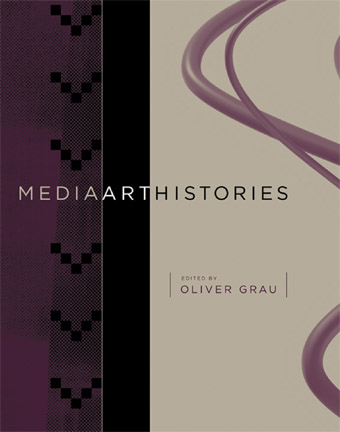the converging of art history and media art
paul thomas reviews oliver grau’s MediaArtHistories

Oliver Grau’s MediaArtHistories
I was in a reviewing reverie as I embraced Oliver Grau’s MediaArtHistories, which brings together the work of media researchers who have been prolific in interpreting the relationship between new media art and art history.
In Australia, with its strong 25-year history in media art, we have witnessed an inevitable pulling back of media art into the immersive folds of traditional visual art. Grau views this process as a positive development. He also demonstrates, however, that traditional notions of visual art will have to be revised to absorb the ineluctable impact of science and technology on contemporary art practice.
Now that media art is integrated into a number of university departments across Australia, transdisciplinary approaches to art practice are demanded. MediaArtHistories provides insights and contexts for some of the theoretical and historical programs being continually revised as the area constantly reinvents itself and expands.
I’ll highlight some of the connecting threads that suggest the book’s transdisciplinary inclusiveness. Gunalan Nadarajan demonstrates that meaning is not fixed and can be recontexualised by exploring media art from different cultural perspectives which he does by exploring the genealogy of the influence of Ibn al-Jazari’s Book of Ingenious Mechanical Devices on the development of mechanical automata in Europe. Machiko Kusahara too addresses the cross-cultural implications of media art through his notion of Device Art, entailing a Japanese alternative to Western art history and an integrative view of art, technology and entertainment.
Sean Cubitt explores constructs of projection referencing the ‘Maid of Corinth’ as a fundamental influence on traditional art practice. He suggests that this traced outline of a shadow created by candlelight has played a strong role in influencing events at the very core of image science. Ron Burnett extends the projection concept to the psychology of projection, of mind as a metaphorical interfacing with technologies, and seeing as active and cultural.
This theme of the cohesiveness of art and media is also expressed in other essays focused on the role of media art as an interdisciplinary and transdiciplinary vehicle bringing together science, technology and art. In his essay, “Historicizing Art and Technology”, Edward Shanken argues for a revision “of the art historical canon…required not only because it corrects an obvious omission but because contemporary artists are increasingly employing science and technology as artistic media.”
Erikki Huhtamo suggests an archaeology of interactivity and tactility in relation to media art referencing works such as Paul Sermon’s Telematic Dreaming which explores intimacy and touch mediated by technology. Oliver Grau addresses phantasmagoria by looking at magic lantern shows in terms of telepresence and artificial life. Lev Manovich explores the effects of science and psychology on abstraction invoking a paradigm of ‘reduction and complexity.’ Dieter Daniels makes interesting parallels between the works of Marcel Duchamp and Allan Turing.
The incremental increase of technological developments makes this reinvention of art history a pressing concern, as highlighted in Christiane Paul’s essay on the role of the curator and the need for galleries to be proactive in this change. Paul expands on current ideas of how the immaterial nature of media art becomes materialised through cables, projectors and the immensely complicated process of media arts installation. She points to the possibility of user-generated and curated media shows, and considers the role of digital commons in reinterpreting the classic role of the gallery. In his essay, Andreas Broeckmann addresses the “aesthetics of the machinic”, pointing out that the ‘machinic’ controls, interprets and processes the decoding of data into the work as conspirator, collaborator or partner.
The essence of MediaArtHistories is encapsulated, in part, by Nadarajan’s essay as it re-examines, re-contexualises and re-focuses our attention on art’s global history, nowadays technologically mediated not least by media art.
The concept for MediaArtHistories as a book came about prior to the first MediaArtHistories conference, Refresh, in 2005. The book is supplemented by the online conference proceedings available as streaming video downloads. The proceedings are a tribute to the network of scholars that instigated the event but also reflect the growing interest in serious academic work being done in this area.
The essays presented in MediaArtHistories comprise a compelling addition to the bookshelf of any academic interested in art history. New media art histories need to be positioned with the growing range of books that are coming to terms with technological, scientific, philosophical and social comprehension of art practice.
Due to the immense rate of change in emergent technologies we are confronted by a continual immersion in flows of data, without the chance to reflect on what is evolving in their wake. The current art paradigm cannot remain stable in dealing with media art. MediaArtHistories allows us to make important connections and realise, perhaps too late, the possible outcomes. These scholarly essays give us some ground on which to stand and perceive emerging patterns.
I hope the next Media Art Histories conference, re:place (Berlin 15-18, November 2007, http://tamtam.mi2.hr/replace/) will spawn a publication of equally high calibre.
MediaArtHistories Archive: http://www.mediaarthistory.org/
MediaArtHistories, editor Oliver Grau, MIT Press, Mass, 2007
RealTime issue #78 April-May 2007






